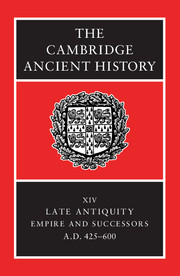Book contents
- Frontmatter
- PART I CHRONOLOGICAL OVERVIEW
- PART II GOVERNMENT AND INSTITUTIONS
- PART III EAST AND WEST: ECONOMY AND SOCIETY
- 12 Land, labour and settlement
- 13 Specialized production and exchange
- 14 The family in the late Roman world
- 15 Family and friendship in the west
- 16 State, lordship and community in the west (c. A.D. 400–600)
- 17 Armies and society in the later Roman world
- PART IV THE PROVINCES AND THE NON-ROMAN WORLD
- PART V RELIGION AND CULTURE
- Conclusion
- Chronological Table
- BIBLIOGRAPHY
- Index
- References
17 - Armies and society in the later Roman world
from PART III - EAST AND WEST: ECONOMY AND SOCIETY
Published online by Cambridge University Press: 28 March 2008
- Frontmatter
- PART I CHRONOLOGICAL OVERVIEW
- PART II GOVERNMENT AND INSTITUTIONS
- PART III EAST AND WEST: ECONOMY AND SOCIETY
- 12 Land, labour and settlement
- 13 Specialized production and exchange
- 14 The family in the late Roman world
- 15 Family and friendship in the west
- 16 State, lordship and community in the west (c. A.D. 400–600)
- 17 Armies and society in the later Roman world
- PART IV THE PROVINCES AND THE NON-ROMAN WORLD
- PART V RELIGION AND CULTURE
- Conclusion
- Chronological Table
- BIBLIOGRAPHY
- Index
- References
Summary
The Roman empire was a structure created and sustained by force that had to be available for deployment both against external threats to the state’s existence and against any of its inhabitants who attempted to reject or avoid its authority. But for its first 250 years the empire managed to maintain a considerable separation between civilian and military spheres: soldiers were legally and socially distinct from civilians, and to a large extent geographically as well, since most major concentrations of troops were located along the empire’s frontiers. As a result, many of the ‘inner’ provinces could appear demilitarized: soldiers might pass along the arterial roads or be on hand when a new census was held, but they were outsiders, in the main recruited from, stationed in and demobilized into other less civilized (i.e. less urbanized) parts of the empire, either the periphery or the uplands and other marginal areas. There was also, however, a close mutual interdependence: the army consumed much of the surplus product of the prosperous peaceful provinces, so that soldier and civilian were tied economically; the emperor was both commander-in-chief of the armies and the ultimate source of law, political authority and social status; provincial governors and most other commanders of armies were members of the senate, the pinnacle of the civilian social structure.
In the late empire this tidy picture was greatly complicated, primarily as a result of extensive tribal invasions: provinces and cities that had once been unmilitary had to remilitarize themselves; the army became an important potential means of political and social advancement, successful tribes created new centres of power where new rules governed relationships; all the time the military had to extract resources from an economy that was often suffering the effects of war.
- Type
- Chapter
- Information
- The Cambridge Ancient History , pp. 469 - 496Publisher: Cambridge University PressPrint publication year: 2001
References
- 19
- Cited by

